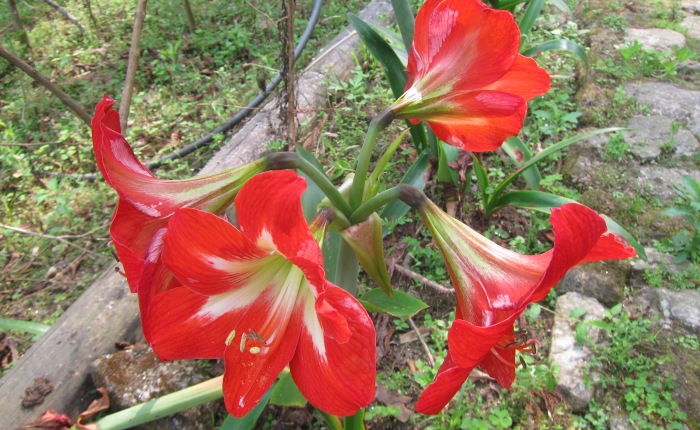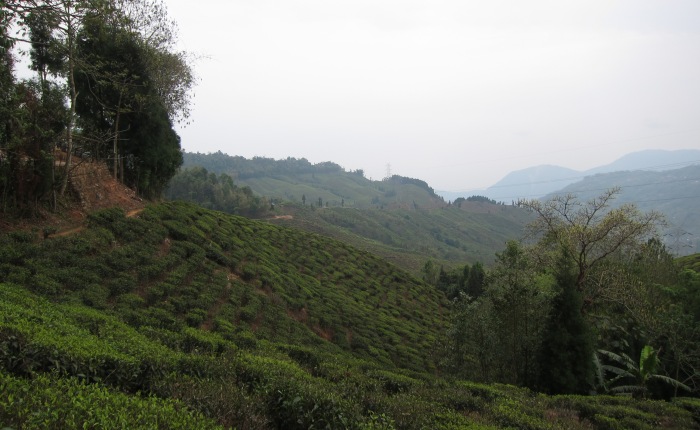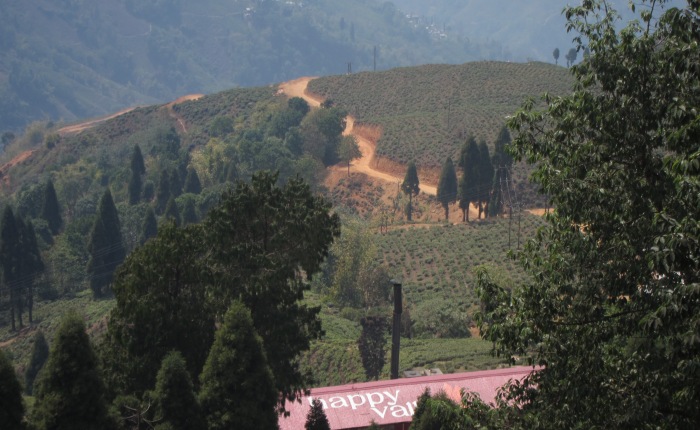In my post about the Sanjukta Vikas Cooperative at Mineral Springs in Darjeeling, I had mentioned that I spent two days in Zimba’s Home Stay. “Zimba” is the home of Passang, who is a member of the Cooperative. He grew up on Mineral Springs and along with his brother, Kisan, he farms his family’s ancestral land. Their village is called Ambotay, in honor of an ancient mango tree that overhangs the main road. Continue reading “Zimba’s Hand Made Tea”
Small is Big: Sanjukta Vikas
At the Life & Leaf Fair Trade shop in Darjeeling they were selling some organic tea produced in Darjeeling by “Mineral Springs.” Unlike the last tea garden I visited, the Makaibari Tea Estate, Mineral Springs is not listed by the Tea Board of India as one of the 87 Darjeeling Tea Gardens, so I was curious to find out more about it. Continue reading “Small is Big: Sanjukta Vikas”
Tea with Rajah Banerjee
After touring the factory at the Makaibari Tea Estate with a group from Young Mountain Tea, I joined them in a tea tasting session with Rajah Banerjee, the owner of the estate. Under Mr. Banerjee’s leadership, Makaibari has become the most famous of Darjeeling’s 87 tea gardens. A fourth generation tea planter, he is known for pioneering natural growing methods and social welfare programs. Continue reading “Tea with Rajah Banerjee”
Makaibari: Organic, Biodynamic Tea
After the Darjeeling Himalayan Railway left me at Kurseong, I made my way to the Makaibari Tea Estate, where I spent two days with a family of tea workers. My hostess, Pushpa, is one of several women participating in Makaibari’s home stay program, initiated by its charismatic and progressive owner, Rajah Banerjee. The program helps generate additional income for the tea communities while providing to the tourist a unique perspective on tea garden life. Continue reading “Makaibari: Organic, Biodynamic Tea”
Darjeeling Himalayan Railway

There are several tea estates near Kurseong, which is about 25 km south of Darjeeling. A Jeep covers the distance in just over an hour, but I rode the train instead, which takes more than twice as long but offers the unusual experience of traveling by a UNESCO World Heritage railway. Continue reading “Darjeeling Himalayan Railway”
Darjeeling Tea Garden Communities
Darjeeling tea gardens, of course, have tea bushes and tea factories. But they also contain residential villages and the social infrastructure to support their people. There are modest homes for the tea workers and bungalows for the garden managers. There are schools, temples, churches, daycare centers, clinics, tailors and small shops. Much of this infrastructure is subsidized by the operator of the garden, but the tea workers don’t own the land under the bushes they pluck. What are the implications of this sort of arrangement?
Thurbo Tea Estate
A few weeks ago I traveled in the Darjeeling district towards the Nepal border, to reach a school in Mirik where I was to do some teaching. The drive was very scenic, with heavy mist meandering through the tall pine trees flanking the twisty mountain road. The Mirik area is home to several of Darjeeling’s famed tea gardens, and after we left the pine forest the rolling hills were covered with tea bushes. Continue reading “Thurbo Tea Estate”
Happy Valley Tea Estate
One of the oldest tea gardens in Darjeeling, Happy Valley Tea Estate was established in 1854. Some of its tea bushes are well over 100 years old. Several years ago the garden began the transition from conventional to organic growing, and now it has both organic and biodynamic certifications. Continue reading “Happy Valley Tea Estate”
Tea Tasting in Darjeeling
Darjeeling tea is plucked in four “flushes” throughout the season: first flush, second flush, monsoon flush, and autumn flush. Tea from each flush has its own distinct qualities and flavor profile. Notably, second flush teas (late spring/early summer) are known for their often prominent, smokey “muscatel” flavor, highly favored by connoisseurs. Continue reading “Tea Tasting in Darjeeling”
Dooteriah Tea Estate
Prior to coming to Darjeeling I had arranged to teach English at Hannah Memorial Academy (HMA), an elementary school on the Dooteriah Tea Estate. Jason, the founder of the school, set up accommodations for me in the guest bungalow on his family’s land on the estate. His family has been living at Dooteriah since the time when Jason’s grandfather was the doctor for the tea estate. Continue reading “Dooteriah Tea Estate”









